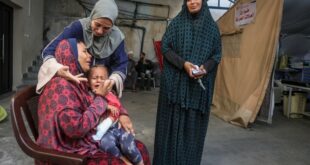Stalled military help and grumpy neighbours have added to Ukraine’s hardships this winter.
Eternally long lines of stalled transport trucks at Ukraine’s border with Poland may be an apt metaphor for broader frustrations and challenges facing the war-weary nation as 2023 winds down.
A blockade by Polish truckers is just one in a series of cascading issues that have combined to thwart Ukraine’s ability to support its military and resist Russia’s almost two-year-old invasion.
“Increasingly, domestic politics [among] Ukraine’s allies is interfering with Ukraine’s security,” said Orysia Lutsevych, an analyst with Chatham House in London who has paid special attention to the war in Ukraine.
In the United States, more than $60 billion US worth of military aid is stalled by Senate Republicans. Another huge financial package worth more than $53 billion from the European Union may be boycotted by Hungary’s Russia-friendly government, and even when nations agree on what assistance Ukraine needs, getting it there quickly can still be a big problem.

For more than a month, a blockade by Polish truckers, as well as a few in Slovakia, has created immense backlogs in moving humanitarian and commercial supplies into Ukraine.
The Polish truckers — who number only a few dozen — have blocked three of the main crossing points between Ukraine and Poland to protest the loss of business because of a flood of Ukrainian truck drivers who are now competing on the main trans-border routes.
“The Russians are the obvious enemies, but this meanness is coming from a friend,” said Ukrainian trucker Roman Kaledin, who spoke with CBC News after finally completing his 1,300-kilometre run from central Poland to Kharkiv, a city in Eastern Ukraine.
He said he was forced to wait on the side of the road at a border crossing for an astounding 16 days before the Polish truckers let him through.
“They [the Poles] didn’t care,” said Kaledin. “Medicines, medical equipment, humanitarian aid, fuel, baby food — it was all waiting in line.”
Crucial shipments delayed by trucking dispute
The Ukrainian truck drivers have made do by converting their rigs into temporary homes as they inch forward over the hours and days. Kaledin showed CBC News the propane stove in his cab he used to cook hot meals while he waited.
With Ukrainian airports closed, shipping through ports reduced and rail movements at capacity, trucking has become one of the country’s main lifelines.
The protesters want an old, pre-war permit system restored so that the number of Ukrainian trucks is limited. But so far, negotiations between Ukraine, Poland and the European Union have been unable to resolve the impasse.
“It’s extremely difficult for us to understand how a small group of people with their private interests can so much influence the situation in Ukraine,” said Serhiy Derkach, Ukraine’s deputy minister for communities, territories and infrastructure.
Derkach told CBC News that while inbound military cargo, such as weapons and ammunition, can bypass the blockade, outbound trucks are still delayed. That creates a ripple effect that can delay successive shipments.
“The waiting time for the trucks actually to come back is extended enormously,” he said.
International aid in question
Derkach hopes once Poland’s new government led by Prime Minister Donald Tusk takes over later this month, it will be possible to make some progress.
But the inconvenience of the truckers’ blockade pales in comparison with the other financial and military obstacles Ukraine’s leaders will have to navigate in the months ahead.
The latest package of U.S. military aid announced this week worth $175 million may be the last until Congress resolves a $60-billion standoff between Senate Republicans and Democrats over U.S. border measures.
On Monday, leaders of the European Union will decide whether to inject a $53-billion infusion of budget support to Ukraine over the objections from Hungary’s nationalist government.
If either or both of those measures fail, Ukraine’s ability to defend itself — much less retake territory now controlled by Russia — would be dealt a crippling blow.
Data from Germany’s Kiel Institute, which tracks humanitarian and military aid to Ukraine, shows that the United States has accounted for almost half of the $100 billion in military aid sent to Ukraine since the start of Russia’s invasion.
If the Congressional bill fails, it would not be possible for other countries to replace that production.
Russia massing military supplies
“When you look back at it, we were expecting Ukraine to do miracles — but this is not a biblical story. It’s a real-life war,” said Lutsevych.
She emphasized that the hopeful assumptions by some in the West that Vladimir Putin could be deterred from continuing his attacks were never realistic.
“We were hoping that somehow [the Russians] will exhaust themselves, you know, that they will change the calculus but they will not. And we know it,” Lutsevych told CBC News.
Increasingly, the focus of U.S. and European assistance has turned toward helping Ukraine build up its own defence industries, so that the country can withstand Russian attacks over years, not just the next few months.
A report this week by Britain’s Royal United Services Institute, a military think-tank, carried an unmistakable note of urgency.
“From a low point in the spring, Russia’s military supply situation has been steadily improving,” it said.
It notes the country has successfully stepped up production of key weapons from 40 long range missiles per month to over 100 per month, with production of tanks, artillery howitzers and drones are also steadily rising.
“Russia is settling down for a long war, aiming to grind down Ukraine and exhaust the capacity and will of its Western supporters to supply the vehicles, ammunition and weapons it needs to keep fighting successfully,” the report concluded.
Putin rallying international allies
Politically, Putin also appears to have tamed whatever domestic opposition initially existed to the war and the death of Russian mercenary leader Yevgeny Prigozhin in a suspicious plane crash appears to have doused any significant challenge to his conduct of the war, despite staggering losses.
On the ground, Russia’s armies have been pressing unrelentingly for weeks trying to retake the town of Avdiivka in Ukraine’s Donetsk region.
One Ukrainian analysis suggested that in October alone, Putin’s armies lost more than 23,000 soldiers, more than 500 tanks and 800 fighting vehicles, although those numbers are impossible to independently verify.

Putin visits Middle East as Ukraine worries about dwindling foreign aid
Ukraine is having trouble getting other economic and humanitarian assistance delivered as aid from the U.S. is stalled in Congress. Meanwhile, Russian President Vladimir Putin is shoring up support from his allies in the Middle East.
More broadly, the Kyiv Post reports that Ukraine’s government believes more than 300,000 Russian military personnel have been killed or wounded since its invasion began in February 2022.
As more evidence of Putin’s resilience, this week Russia’s leader made a flurry of international visits to the Middle East for meetings with the leaders of Saudi Arabia and the United Arab Emirates. He also welcomed Iran’s president to Moscow.
“These visits prove to the elite, the Russian audience, that their country is not isolated and it’s still welcomed by lots of places in the world,” said Nikolay Kozhanov, a research associate professor at Qatar University’s Gulf Studies Center.
Kozhanov said Putin’s adaptation of Russia’s economy to support the war is likely to be sustainable for the next several years, but at the expense of long-term efforts to expand its production base and innovate.
That will likely lead to dire consequences for growth at some point but as he heads into the presidential elections in March, Putin’s position to indefinitely wage his war is strong, said Kozhanov.
“Putin has managed to create a perception that things are going on as normal,” he said.
In Ukraine, President Volydmyr Zelenskyy, who has doubled as the country’s cheerleader-in-chief, took a video of himself walking through Kyiv’s downtown this week, saying hello to people and trying to project a sense of calm amid the uncertainty.
“Victory is ahead, he said. “Could there be an alternative? We all know — no.”
‘Ukraine is wounded and bitter, but it’s not broken’
This week, Ukraine also took some significant — although not immediate — steps to begin manufacturing more of the Western weaponry that it currently relies on other countries to donate.
Two U.S. firms announced they will help Ukraine set up production lines to manufacture 155-millimetre artillery shells, which are the mainstay of Ukrainian combat units.
However, Ukrainian officials noted it could be between two to three years before production actually begins.
The country’s minister for strategic industries has said Ukraine is also now manufacturing a variety of its own armaments, including drones and missiles.
Lutsevych, the Chatham House analyst, says she detects disappointment and frustration from Ukrainian officials toward the muddled Western messages and assistance, but not panic.
“Ukraine is wounded and bitter, but it’s not broken.”
ABOUT THE AUTHOR

Foreign Correspondent
Chris Brown is a foreign correspondent based in the CBC’s London bureau. Previously in Moscow, Chris has a passion for great stories and has travelled all over Canada and the world to find them.
*****
Credit belongs to : www.cbc.ca
 Atin Ito First Filipino Community Newspaper in Ontario
Atin Ito First Filipino Community Newspaper in Ontario






